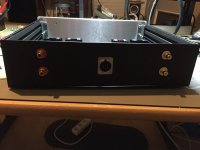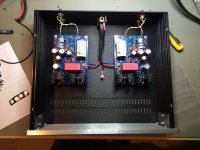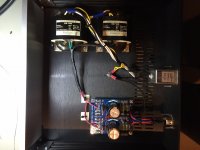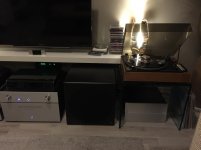I don't see the PE spot on the raw board connected to your IEC ground now that I look back. PE is protective earth, not your signal ground. PE goes to the IEC's third prong (earth) that should also be connected with a short wire to the raw PSU chassis secured with screw and safety nut.
I have been working with the power supply for my SALAS and think I have come up with something worth noting.
I am not making a comparison to the specified supply since I have never used it. This is about the evolution of the supply I am using.
I had a pair of old power transformers I had from an old DYNACO ST150 power amps laying about for decades and decided to use these. They are 45 volts center tapped. I originally used a pair of CREE SIT rectifiers feeding into 10 uF of input capacitance (selected to get the output voltage I needed) into a 5 Hy 25R choke then into 4700 uF of electrolytic, nothing special, and then to the input of the phono amp.
I thought this sounded good since the phono circuit sounds good.
I read about this rectifier at JEFF'S PLACE, and interesting blog. Jeff has been corresponding with a Mr. Yazaki of SPEC CORPORATION about upgrading his old McINTOSH MC-30s and some parts were recommended to him to use. The part that surprised me was this rectifier - STTH6110TV. Mr. Yazaki made the comment that this rectifier was as good as any tube rectifier he had used. This would be menaingless coming from most people but Yazaki has been experimenting a long time with audio gear and especially with tubed gear so I thought I must give this a try.
They are fairly expensive as far as SS rectifiers go. There are two in the assembly which is all I needed so I ordered a pair. I had experimented with rectifiers in the past and had not found there to be as much difference between them as I would have liked. I found there are plenty that sound bad and none that surprised you with their GOOD sound.
I know it sounds all too typical but upon playing the first record after installation the sound was so different it was as if I had placed a completely different phono in the system. To save the foolish verbiage all of those qualities we love to be enhanced were enhanced. The spaciousness of the presentation, along with the tone of the instruments was so much more complete I laughed to myself. It was simply an amazing and unexpected difference. I thought I was going to have to work at hearing a difference. Of course, all of us know when we make a change we EXPECT to hear a difference, the biggest foible of DIY audio. For the next few days I would expect reality to return and the qualities I thought I was hearing would go away but every time these qualities would be obvious.
After three weeks it is the sound I expect to hear so I no longer can hear the difference, I have no memory of the old sound, at this point.
As always one thinks what can be done to get more of this.
I had some ASC motor run caps that have been laying about for years and thought: there is something going on with this rectifier when it converts AC to DC - it is doing is so well and with so few artifacts one might not need so much capacitance in the raw supply. I installed 150 uF of these ASC cans into each supply. One figures there might be more noise with this great reduction in capacitance. I know with film caps one is able to get by with less capacitance than with electrolytics but you never know until you try.
I can say there is no more noise than what I heard before and I have to join those who say one should never use an electrolytic anywhere in an audio circuit. There is that oft-reported loss of graininess, the sound of instruments has greater body and completeness. The qualities I heard from the replacement of the rectifiers is greater still.
Now I am trying to figure how to use them on the main circuit board. Will have to build a new box and I worry that some of the leads from board to caps will not be an ideal length, otherwise known as zero, but I think it is worth a try. Luckily the ASCs are not that expensive here. I have been told the DUCATI caps are excellent for this purpose and available in Europe. (They are not available here in the US)
All I can say is that the SALAS circuit is very, very fine and quickly reveals what is holding it back. It is worth being foolish with one's power supply - it deserves the best you can do.
My supply is gigantic but not in comparison to some exotic tubed phonos I have seen but nonetheless it is a monster compared to the circuit itself. When I fit the large caps the circuit box might approach the size of the power supply. A pain I am willing to suffer.
I hate to be the bearer of bad news but the SALAS circuit responds enthusiastically to no electrolytics in the raw supply. I can only imagine there will be similar gains at the PCB, if not greater still, damnit.
I know I have done nothing new here but can assure those who want to go further with this phono amp that your efforts will not be wasted. I feel even now I am hearing the qualities ascribed to the best tubed stages with the advantage of lower noise and no need for an expensive input transformer for the MC and certainly at a cost that can only be described as a bargain.
Nonetheless, I must repeat, that rectifier is the cornerstone for this improvement. Everything starts at the beginning ...
I am not making a comparison to the specified supply since I have never used it. This is about the evolution of the supply I am using.
I had a pair of old power transformers I had from an old DYNACO ST150 power amps laying about for decades and decided to use these. They are 45 volts center tapped. I originally used a pair of CREE SIT rectifiers feeding into 10 uF of input capacitance (selected to get the output voltage I needed) into a 5 Hy 25R choke then into 4700 uF of electrolytic, nothing special, and then to the input of the phono amp.
I thought this sounded good since the phono circuit sounds good.
I read about this rectifier at JEFF'S PLACE, and interesting blog. Jeff has been corresponding with a Mr. Yazaki of SPEC CORPORATION about upgrading his old McINTOSH MC-30s and some parts were recommended to him to use. The part that surprised me was this rectifier - STTH6110TV. Mr. Yazaki made the comment that this rectifier was as good as any tube rectifier he had used. This would be menaingless coming from most people but Yazaki has been experimenting a long time with audio gear and especially with tubed gear so I thought I must give this a try.
They are fairly expensive as far as SS rectifiers go. There are two in the assembly which is all I needed so I ordered a pair. I had experimented with rectifiers in the past and had not found there to be as much difference between them as I would have liked. I found there are plenty that sound bad and none that surprised you with their GOOD sound.
I know it sounds all too typical but upon playing the first record after installation the sound was so different it was as if I had placed a completely different phono in the system. To save the foolish verbiage all of those qualities we love to be enhanced were enhanced. The spaciousness of the presentation, along with the tone of the instruments was so much more complete I laughed to myself. It was simply an amazing and unexpected difference. I thought I was going to have to work at hearing a difference. Of course, all of us know when we make a change we EXPECT to hear a difference, the biggest foible of DIY audio. For the next few days I would expect reality to return and the qualities I thought I was hearing would go away but every time these qualities would be obvious.
After three weeks it is the sound I expect to hear so I no longer can hear the difference, I have no memory of the old sound, at this point.
As always one thinks what can be done to get more of this.
I had some ASC motor run caps that have been laying about for years and thought: there is something going on with this rectifier when it converts AC to DC - it is doing is so well and with so few artifacts one might not need so much capacitance in the raw supply. I installed 150 uF of these ASC cans into each supply. One figures there might be more noise with this great reduction in capacitance. I know with film caps one is able to get by with less capacitance than with electrolytics but you never know until you try.
I can say there is no more noise than what I heard before and I have to join those who say one should never use an electrolytic anywhere in an audio circuit. There is that oft-reported loss of graininess, the sound of instruments has greater body and completeness. The qualities I heard from the replacement of the rectifiers is greater still.
Now I am trying to figure how to use them on the main circuit board. Will have to build a new box and I worry that some of the leads from board to caps will not be an ideal length, otherwise known as zero, but I think it is worth a try. Luckily the ASCs are not that expensive here. I have been told the DUCATI caps are excellent for this purpose and available in Europe. (They are not available here in the US)
All I can say is that the SALAS circuit is very, very fine and quickly reveals what is holding it back. It is worth being foolish with one's power supply - it deserves the best you can do.
My supply is gigantic but not in comparison to some exotic tubed phonos I have seen but nonetheless it is a monster compared to the circuit itself. When I fit the large caps the circuit box might approach the size of the power supply. A pain I am willing to suffer.
I hate to be the bearer of bad news but the SALAS circuit responds enthusiastically to no electrolytics in the raw supply. I can only imagine there will be similar gains at the PCB, if not greater still, damnit.
I know I have done nothing new here but can assure those who want to go further with this phono amp that your efforts will not be wasted. I feel even now I am hearing the qualities ascribed to the best tubed stages with the advantage of lower noise and no need for an expensive input transformer for the MC and certainly at a cost that can only be described as a bargain.
Nonetheless, I must repeat, that rectifier is the cornerstone for this improvement. Everything starts at the beginning ...
All electrolytics you see on the main board are just local RC filters stemming from the rail, none in the direct signal path. Using big film caps there would render the layout huge and susceptible to loop area interference. Constructing the FSP like a Jadis amp would be something I am not that sure I will never see from some member here eventually though.
Thanks for your components tips, its nice you always try push the envelope of your system.
Thanks for your components tips, its nice you always try push the envelope of your system.
And the amp box is ready
No TT ground wire lug?
It works!!!! Sounds good.... Set has to warm up
No hum, very quit!!! Nice!
The quick one
Ah that! No, my turntable does not have that.... Don't know why not.... Maybe because it ia all wood? Or just missingit's old! But boy does it sound great!
Rega does not have that either. There is very few makers TT practice of mixing the arm and chassis ground along the signal return ground. Often criticized by others also. Anyway as I am not entirely sure about how your grounding works there or how exactly you wired everything, since you declare the system quiet I rest my case
In my all rega system I had a lot of hum. I had to run a piece of wire from the turntable's power supply (I loosened the back panel screw to connect the wire) to the amplifiers ground lug. Hum stopped! The dealer which is quite experienced with rega systems said he never had such a problem!
It might have something to do with running the ground wire in the signal return wire.
It might have something to do with running the ground wire in the signal return wire.
The quick one
Hahaha, took me the whole day to put together...... Everything was pre-worked. Today was only assembly.
But yeah, I was tired of listening to my factory Phono Amp from Cambridge. This one is something else!

 Much more musical and much more transparent.
Much more musical and much more transparent. I only had to decrease my subwoofer a bit. Could that be the 47nF cap? Still have to buy the good stuff for those instead of the orange drop ones.
In my all rega system I had a lot of hum. I had to run a piece of wire from the turntable's power supply (I loosened the back panel screw to connect the wire) to the amplifiers ground lug. Hum stopped! The dealer which is quite experienced with rega systems said he never had such a problem!
It might have something to do with running the ground wire in the signal return wire.
Rega does only the arm body ground through the signal wire shield I think where Sjoerd's TT may be doing the other metal parts also. Grounding mysteries aside he beat us all by going hum-less on first shot with a non ground wire TT and his magic wire dressings and star bolts
Rega does only the arm body ground through the signal wire shield I think where Sjoerd's TT may be doing the other metal parts also. Grounding mysteries aside he beat us all by going hum-less on first shot with a non ground wire TT and his magic wire dressings and star bolts
Whahahahaha, It works
- Home
- Source & Line
- Analogue Source
- Simplistic NJFET RIAA



